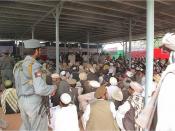Cultural diversity in effective work place conflict resolutionJirga in Afghanistan vs. Canadian court system A case based approach introduction:Conflicts of various kinds are as old as the human civilization. Humans on an individual level or collectively in the form of a tribe, nation or ethnic group have had mild to severe conflict over scarce, yet much needed, resources such as - land, money, political power, and ideology. History is full of examples of conflicts over intangibles such as ideological and religious positions that have been severe enough for involved parties to attempt to completely eliminate the opponent from the face of the planet for example crusader wars, Holocaust etc. Therefore conflict in its various forms is as much a constituent of human society as oxygen in the atmosphere. Fortunately at the same time, humans have found their own ways and means for averting and/or resolving conflicts.
The existing body of literature confirms that the nature and causes of conflicts and methods for resolution are deeply rooted in the culture and history of every society and at times are unique in there own way i.e.
best fit for each group of people within the context of their religion , culture and resources. Panchayat in India (Baxi and Gallanter 1979; Moore 1985), Mediation Committees in China (Li 1978; Clark 1989), and Jirga in Afghanistan (Carter and Connor 1989; Elphinstone 1992; Olesen 1995; Gletzer 1998) that operate as informal mechanisms of conflict resolution differ from one another significantly. More importantly, all these traditional forms of conflict resolution are fundamentally different from the ways conflicts are resolved in much of the Western world (Reichel 1998).
These comparative social facts would seem to support the philosophical position of cultural relativists who have long argued that the nature of all social phenomena, including conflicts and their...

